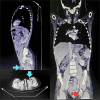Challenging diagnosis: unusual presentation of Unicentric Castleman disease-a case report
- PMID: 39990022
- PMCID: PMC11845339
- DOI: 10.1093/omcr/omae181
Challenging diagnosis: unusual presentation of Unicentric Castleman disease-a case report
Abstract
Castleman's Disease is an idiopathic rare lymphoproliferative disorder that is clinically Classified to multicentric to unicentric types. Only few cases were reported in children, with majority of them are unicentric and usually located in the mediastinum. We report a unique case of a 13-year-old boy who presented with a palpable enlarged mass in the left inguinal region without any constitutional symptoms. Surgical removal of this mass was essential to exclude worrying causes. Pathologic examination revealed proliferative changes consistent with Castleman's disease plasma cell type which is one of the rarest forms of the disease in children. To our knowledge, this case is the first reported case of Unicentric Castleman Disease (UCD) in the inguinal area. During a 12-month-period of follow-up, no additional lymph node enlargements or other symptoms were reported. In conclusion, any isolated lymph node enlargement wherever it is, especially in a child, should impose UCD as a possible differential diagnosis.
Keywords: Castleman disease; Pediatrics; Unicentric Castleman’s disease; inguinal lymph nodes; surgery.
© The Author(s) 2025. Published by Oxford University Press.
Conflict of interest statement
The authors declare that they have no competing interests.
Figures


References
Publication types
LinkOut - more resources
Full Text Sources

